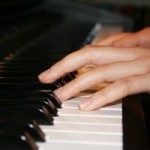Touch & Go
 Megan sighed, “I’ve never been able to play louder with one hand and softer with the other. I just can’t do it.” We had been working on balance of layers in her Chopin Waltz. Megan is 14 and just began studying with me this fall. She has innate musicality and great learning skills but, I think, because she has had 5 piano teachers in about that many years, some things, like balance, have fallen by the wayside. Or, maybe she has just matured to the point that she now hears the voices shouting as they valiantly try to be heard above each other.
Megan sighed, “I’ve never been able to play louder with one hand and softer with the other. I just can’t do it.” We had been working on balance of layers in her Chopin Waltz. Megan is 14 and just began studying with me this fall. She has innate musicality and great learning skills but, I think, because she has had 5 piano teachers in about that many years, some things, like balance, have fallen by the wayside. Or, maybe she has just matured to the point that she now hears the voices shouting as they valiantly try to be heard above each other.
So, we switched places. I played it her way and then I played it my way. “Do you see anything different happening between the two ways?”, I asked. “You don’t touch all the keys in the same way.”, she said. I told her that I felt as though I used the harder tips of my fingers for the melody and bass line and my fingers lay flatter for the chords.
We experimented. She said she had never thought of using the same hand in two different ways (bass line and chords). I told her about something my undergraduate teacher used to tell us. If you want your fingers or your hands to sound the same, then you have to use them in the same way. Then, I asked her what she thought the opposite of that was. “Oh,” she said, “if you want something to sound different, then you have to do something different!”
Last week, her performance of the Waltz has vastly improved and she seemed so much more relaxed as she played. We reviewed our lesson on balancing voices and applied it to another piece. She seemed relieved to be moving forward rather than hitting the proverbial wall.
I’m grateful to her for reminding me of that important lesson from my undergraduate years. My private students have been preparing for the Piano Area Recital at the College this Thursday and quite a few of them have benefitted from a similar experimentation with balance.
Does all this gesturing really change sound? Some say emphatically not. Some say the naysayers and their studies are a plot by digital retailers to help make the case that their products are just as good as acoustic instruments. Some advocate using a compendium of different gestures and body motions to vary tone qualities.
I don’t know if the science of the whole thing matters. If I can use words like pointed, or flat, or circular, or rotation to help my students feel a tactile connection to a particular sound, they will be able to make that sound whenever they want.
And that, to me, is what counts.



Thanks for the great idea. Another thing I do for balance of voices in a single hand is have the student play the layers with 2 hands so they can hear what they want and then do it in one hand.
Thanks for the post! Balance often seems to be an issue with my beginning students. I like the idea of not touching all the keys in the same way to achieve the balance. I’ve never really thought of that before in quite that way. Although I am on the side of different gestures in these ways don’t necesarrily change the sound. But I totally agree that the science of the whole thing doesn’t matter. If the explanation helps a student, that is exactly what counts.
One thing that I do that seems to help with balance is tell the student to play hands separately at the two volumes they want, but only one note/chord at a time. Then they alternate between the two hands. So for example they would play the left hand soft, and then the right hand loud separately even though in the music they will eventually be playing them at the same time. This seems to be a lot easier because they can focus on just one hand. As they get better at this I tell them to play the right hand much quicker almost at the same time as the left hand. They would keep doing that until their hands are playing at the same time, and at different dynamics. The students really seem to like this approach because they can see progress immediately.
Thanks again for the great idea and post!